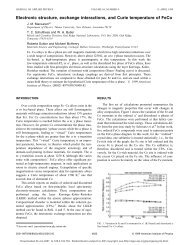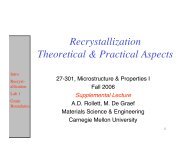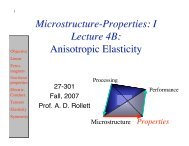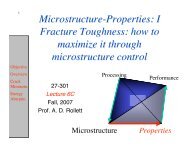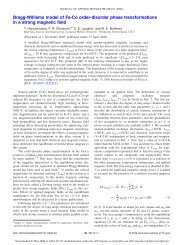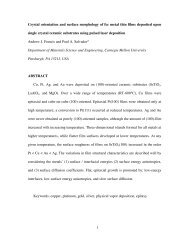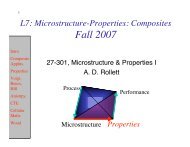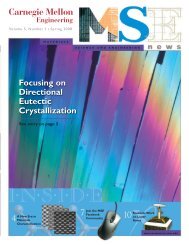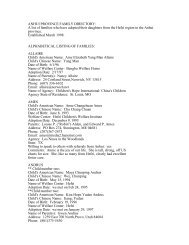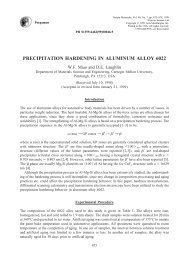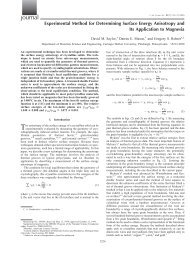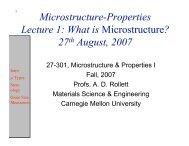Precipitation In Al-Mg-Si Alloys with Cu - Materials Science and ...
Precipitation In Al-Mg-Si Alloys with Cu - Materials Science and ...
Precipitation In Al-Mg-Si Alloys with Cu - Materials Science and ...
Create successful ePaper yourself
Turn your PDF publications into a flip-book with our unique Google optimized e-Paper software.
increase the relative proportion of L to β” phase at peak age increases [7]. The L phase also<br />
becomes more prominent <strong>with</strong> overaging.<br />
<strong>Precipitation</strong> in ternary excess-<strong>Si</strong> alloys provides a notable contrast to that in ternary<br />
balanced alloy. Segalowicz et al. [7] observed β” present at peak age together <strong>with</strong> a lath shaped<br />
metastable phase, designated βd”, that preferentially precipitated on dislocations. This phase was<br />
replaced on over aging by a phase termed M. M, which has similar lattice parameters, crystal<br />
structure (hexagonal) <strong>and</strong> morphology (lath) as the quaternary metastable phase Q’, was the only<br />
phase present on prolonged over aging (OA3). However, it was replaced later by β the stable<br />
equilibrium phase. Matsuda et al. [5,6] reported the occurrence of a lath-shaped, hexagonal<br />
metastable phase, denoted as Type B, on over aging which was replaced on prolonged over aging by<br />
another metastable phase, termed Type C, in a “Ternary, Excess-<strong>Si</strong> (low)” alloy. Type C which<br />
shares similar precipitate characteristics as M <strong>and</strong> Q’ (see Table 1) was replaced, as was M, by β the<br />
stable equilibrium phase. A metastable hexagonal phase Type A, different from Type B, was<br />
observed by the same authors in “Ternary, Excess-<strong>Si</strong> (high)” alloys, which was replaced at<br />
equilibrium directly by the stable (<strong>Si</strong>) phase. The above studies clearly indicate that metstable<br />
phase(s) sharing the precipitate characteristics of the quaternary metastable Q’ phase can be formed<br />
in over aged ternary alloys <strong>with</strong> excess <strong>Si</strong> content. This is noteworthy, since Q is stable only as a<br />
quaternary phase, while a metastable version of it can be formed even in ternary alloys in the<br />
presence of excess <strong>Si</strong>.<br />
The existence of a metastable ternary phase (termed M by [7] <strong>and</strong> Type C by [5]) that has a<br />
similar structure as the Q' phase is an interesting finding. The Q phase has a structure similar to<br />
that of Th7S12 in which <strong>Si</strong> atoms take the place of the Th atoms <strong>and</strong> <strong>Al</strong> <strong>and</strong> <strong>Mg</strong> atoms are r<strong>and</strong>omly<br />
placed on the sites occupied by S in the prototype structure. <strong>In</strong> addition, <strong>Cu</strong> atoms are thought to<br />
be placed at other sites that are not occupied in the Th7S12 structure [11]. One explanation of the<br />
ternary Q' like phase (M or Type C) is that these sites are not occupied in the ternary structure. The<br />
structure has the same space group designation as the Q phase <strong>and</strong> similar lattice parameters <strong>and</strong><br />
would be practically indistinguishable from the Q phase by normal diffraction techniques.<br />
Detailed systematic studies including high resolution TEM by Cayron et al. [12,13] on <strong>Al</strong>-<br />
<strong>Mg</strong>-<strong>Si</strong>-<strong>Cu</strong> alloys, derived from reactions in metal matrix composites, also revealed several<br />
metastable phases to Q, namely the hexagonal QP at peak age <strong>and</strong> the hexagonal QC similar to<br />
Type B on over age. It has been shown by Cayron that the sequence of precipitation:<br />
QP → QC → Q<br />
can be understood as an atomic ordering process <strong>with</strong>in the basal plane of the hexagonal lattice.<br />
The c lattice parameter is the same for each of the phases (see Table 1) while the a lattice parameter<br />
varies from that of QP to 3 times that of QP (QC phase) to 7 times that of QP (Q phase).<br />
These different phases have the same stacking sequence of the basal planes (ABAB…) but different<br />
arrangements of atoms <strong>with</strong>in the basal planes. This proposal of Cayron nicely ties together several<br />
of the structures shown in Table 1.<br />
Strengthening Phases<br />
Numerous studies indicate that the strengthening phase involved in the <strong>Al</strong>-<strong>Mg</strong>-<strong>Si</strong> ternary alloys is<br />
the metastable β” phase [2, 8]. This phase is a precursor to the metastable β’ phase which in turn is<br />
a precursor to the equilibrium β phase. Thus, the increased strengthening in excess-<strong>Si</strong> alloys has<br />
been ascribed to a greater volume fraction of β” formation. <strong>In</strong> quaternary <strong>Al</strong>-<strong>Mg</strong>-<strong>Si</strong>-<strong>Cu</strong> alloys, the<br />
strength was observed to increase progressively <strong>with</strong> increasing <strong>Cu</strong> additions. Here again some<br />
ascribed this to the formation of more β” <strong>and</strong> in finer sizes. <strong>In</strong> what follows, these interpretations<br />
will be analyzed <strong>with</strong> reference to some of our experimental results <strong>and</strong> some recent literature data.



